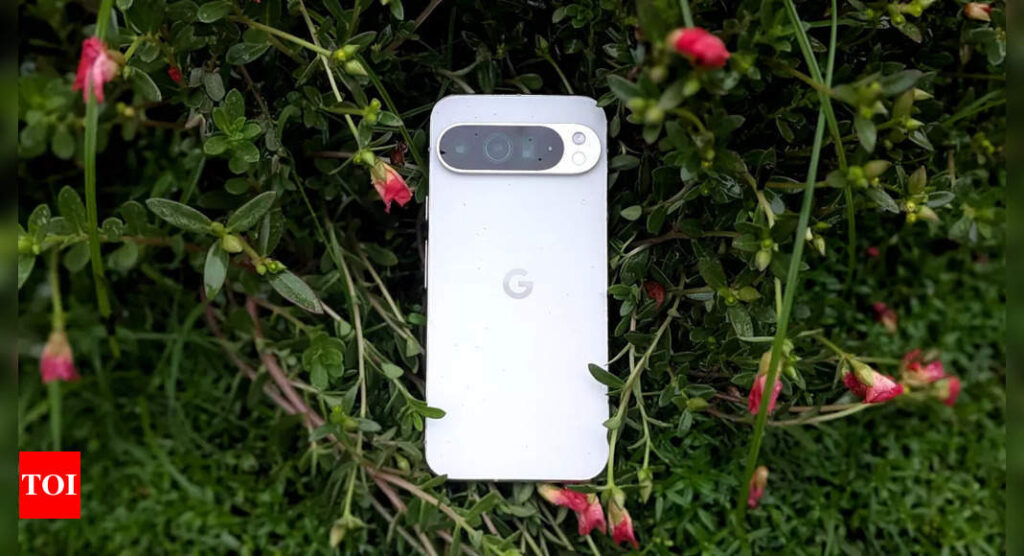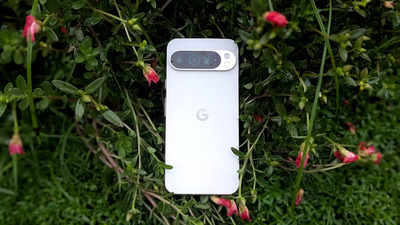
Rating: 4/5
Google CEO Sundar Pichai said in an interview last year that AI will make smartphones much more natural and intuitive to interact with, and unlike in the past years where humans adapt to computing, AI will actually enable computers to actually adapt to humans. Google, a company renowned for its software prowess, has consistently sought to demonstrate the transformative power of software in everyday life.Their Pixel smartphones have become a prime example of this, and the latest Pixel 9 series is no exception. These devices showcase Google’s latest innovations, particularly in the realm of AI, pushing the boundaries of what a smartphone can achieve.
Google’s Pixel 9 series includes the Pixel 9, Pixel 9 Pro, Pixel 9 Pro XL, and Pixel 9 Pro Fold, offering a range of options for users. The Pixel 9 Pro XL is the company’s top-of-the-line candybar phone in the lineup that aims to combine Google’s strengths in AI and computational photography with a refined design and a suite of impressive features.
But how does it measure up in real-world use? We’ve been using the Pixel 9 Pro XL as our primary phone for a month, putting its camera, display, performance, and AI features to the test. In this review, we’ll delve into our experience and assess whether the Pixel 9 Pro XL – priced starting at Rs 1,24,999 – lives up to the hype.
Google Pixel 9 Pro XL design and display
Despite its large size, the Pixel 9 Pro XL is comfortable to hold, with no sharp edges digging into your palm. The camera visor naturally rests against your index finger, providing a secure grip – something we have already seen in older Pixel smartphones. It is available in four colour options: Rose Quartz, Hazel, Obsidian, and Porcelain. We got the Porcelain colour for review.
The Pixel 9 Pro XL retains the core design elements introduced with the Pixel 6 series, which marked a significant shift with its Tensor G series chips and prominent camera visor. However, Google has refined the design, opting for a smaller camera bar that blends more seamlessly with the back panel. The phone features flat sides with a metallic texture, complemented by a matte finish on the back.
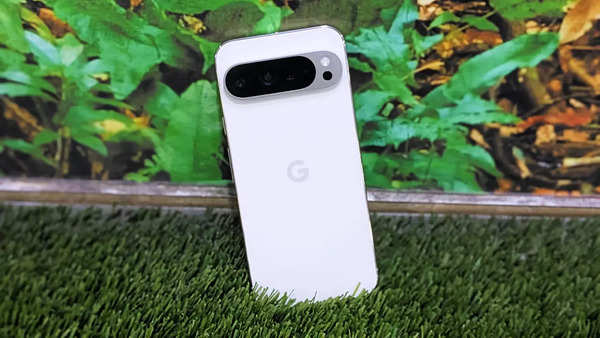
The visor design has changed a bit with cameras now stacked in a pill-shaped window, complemented by a temperature sensor and LED flash. Despite the protruding camera module, the phone remains comfortable to hold and doesn’t wobble when placed flat. The chassis is made of recycled, shiny aluminium – reminiscent of older iPhone models – that is a fingerprint magnet. The design has changed but the identity of a Pixel smartphone remains.
We would have been absolutely satisfied with some minor refinements. The overall quality still lacks the A+ rating when compared with flagships from other companies.
The Pixel 9 Pro XL sports a 6.8-inch OLED display that is a visual treat. Called Super Actua display, it’s an 20:9 aspect ratio (which means a tall stance), 1344 x 2992 pixel resolution at 486ppi for sharper texts and up 3000 nits peak brightness for legibility under harsh sun conditions.
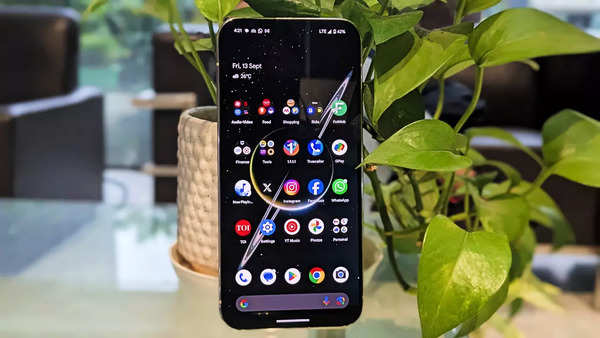
Protected by Corning Gorilla Glass Victus 2 cover glass, the display offered 2,000,000:1 contrast ratio, HDR support and full 24-bit depth for 16 million colours – which translates to vibrant colours, deep blacks and excellent dynamic range.
It’s an LTPO display, which means that the refresh rate will be adjusted as per the content on it, thereby saving some battery for the times when it matters the most. Hence, whether you’re browsing the web, watching videos or gaming, the display delivers an immersive experience.
The Google Pixel 9 Pro XL is the most beautiful and refined Pixel smartphone to date.
Google Pixel 9 Pro XL performance
Google Pixel 9 Pro XL is powered by the Tensor G4 SoC that brings an incremental update over its predecessor. The SoC is built on Samsung’s 4nm process node – similar to the Tensor G3 – but the G4 has newer ARM cores. It has one Cortex-X4 core, three Cortex-A720 cores, and four Cortex-A520 cores – all of them getting a clock speed bump.
There is also a boost in GPU frequency – which means better graphics. The company also claimed that the Tensor G4 can deliver up to 20% better battery life than the Tensor G3. Along with the bump in the chipset, the new Pixels also come with Exynos 5400 modem for better network reception and connectivity as compared to its predecessor.
The heating issues have also been resolved to an extent and unlike older phones that became ‘hot’ while using for longer durations, Pixel 9 Pro XL passed the tests with ease. While there were still traces of heating, we can clearly say it is a great improvement.
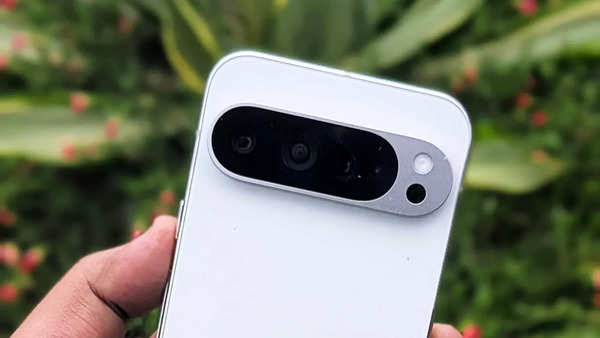
Now, Tensor G4 is not comparable to the flagship Qualcomm Snapdragon and Apple A series chips in terms of raw performance but it isn’t meant to be. Google has designed these chips to handle AI and machine learning tasks, and undertake most of these processes on device.
The Pixel 9 Pro XL handles everyday tasks with ease. Whether you’re browsing the web, streaming videos or making calls, the phone performs smoothly and efficiently. While it delivers a smooth gaming experience for casual titles, it may not be the best option for those seeking top-tier performance in demanding games.
For example, we play Shadow Fight 4 with our peers on a regular basis. In our Pixel 8 Pro review, we particularly mentioned that the phones started to heat up 3 bouts into the game but that wasn’t the case with Pixel 9 Pro XL. The phone handled the game, and others like COD: Mobile, pretty well. Having said that, the Pixel 9 Pro XL is not an ideal smartphone for longer gaming sessions.
Pixel 9 Pro XL software and AI features
A large part of the Pixel 9 Pro XL performance is its software and AI prowess. While it does not bring the firepower to run the games at their highest settings, it compensates for AI features and knitted software. Google calls it the most advanced AI on Pixel.
The phone, surprisingly, runs on Android 14 and offers a clean, bloatware-free interface with a promised seven years of OS upgrades. This translates to a smooth, uncluttered experience that’s both intuitive and responsive. It allows for extensive personalisation and dynamic theming adapts the system colours to the wallpaper, creating an individualised look.
Google AI software powered by Gemini Nano
Google Pixel 9 Pro XL has all those features that were launched in Pixel 8 Pro, plus enhancements and a bunch of new ones to help navigate daily working. All those features are powered by Gemini Nano large language model (LLMs). While many features are handled locally on the device, some require an internet connection to leverage cloud computing capabilities.
Let’s start with the AI features we know. The first is Circle to Search that was launched on Samsung Galaxy smartphones but was then rolled out to all Pixel smartphones. Tap on the bar just above the chin of the screen and you can circle or highlight a part on your screen you want to get more information on, and Google will find it for you on Search.
Another feature is AI-powered Google Assistant which is now known as Gemini, then there is Recorder app which uses AI to transcribe audio in real time, AI wallpapers and Live Translation, which we used a lot during our recent trip to Berlin. For example, we used AI to read road signs, information on tickets of public transport, goodies we bought and even for navigation.
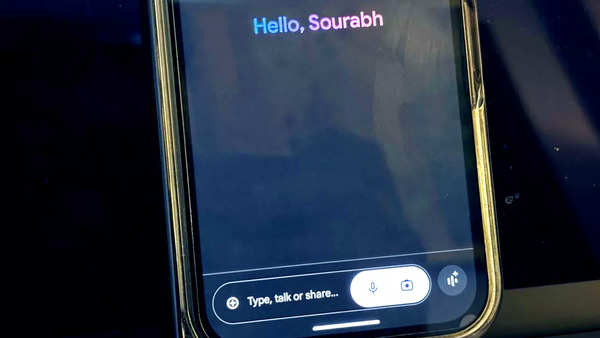
The new additions to the list include Pixel Screenshots app, Weather app, Gemini Live and a bunch of new photos-related tools.
Pixel Screenshots app comes pre-installed on the Pixel 9 Pro XL and it holds all the screenshots that we took during our time with the phone. It even imported our screenshots from our old phone. The purpose of this app is to help users save info that they want to remember later, like events, places and more. The AI in the app presents the information by searching for information related to our query.
For example, to connect to the office Wi-Fi, we need to have certain information handy. We took a screenshot of the information about 2 years ago and Pixel quickly brought that information on top when we wrote, “Wi-fi information about Times internet” in the search bar. This saved minutes that we would have spent going through scores of screenshots that we have on our phone.
Another new AI feature is Gemini Live that allowed us to have a natural, free-flowing conversation with AI as if we are talking to a person with loads of knowledge. Consider it a JARVIS from Iron Man films but just on the phone. It provides updated information, which can be incorrect sometimes.
For example, we asked for a score of a match between FC Barcelona and Athletic Club at half time. It gave us the correct score, however, the information on the manner in which the goal was scored was incorrect. It was an open play goal but the AI said it was a penalty kick.
Coming to Weather app, it’s an all-new application for Pixel 9 series that provides AI-generated summary. Moreover, we can summon the AI at any point in time and ask whatever we want either by typing or by speaking.
Photography-related AI features
Google has refined some AI features like Best Take – that allows users to change the expressions in an image to get the best group photo by combining similar photos – and Photo Unblur in Google Photos that sharpens fuzzy pics, no matter when or where it was taken.
The Google Pixel 9 Pro XL gets the Magic Eraser that removes people in the background to make photos cleaner. The Magic Editor also gets an update. Apart from moving people and objects to make meaningful images, it can now suggest the best crop and reframe photo, or even expand an image to get more of the scene – all with AI.
We could even alter the background of the images we took to essentially transform a random image into a meaningful memory.
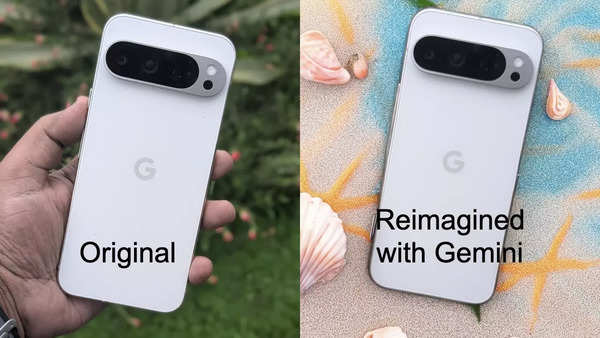
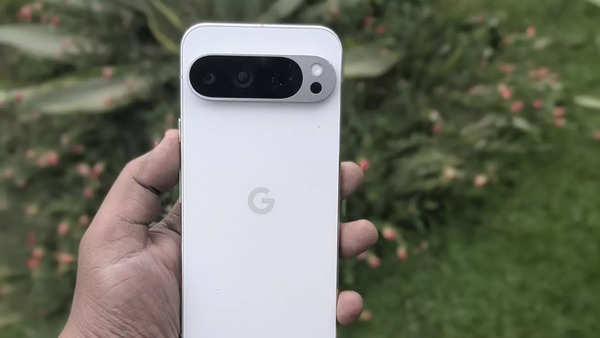
New AI features coming to Pixel 9 Pro XL is Add Me that ensures no one is left out of group photos. After taking a group picture, we swapped the photographer with the person on the screen and took another picture. The Pixel 9 Pro XL then intelligently merged the two images, seamlessly adding the photographer into the group shot.
Another feature is Zoom Enhance that utilises AI to enhance details and improve image quality, resulting in sharper and clearer photos even at high zoom levels.
Google Pixel 9 Pro XL camera
The Pixel 9 Pro XL boasts an impressive camera system that builds on Google’s legacy of smartphone photography excellence. Here’s a breakdown of its key features and specifications:
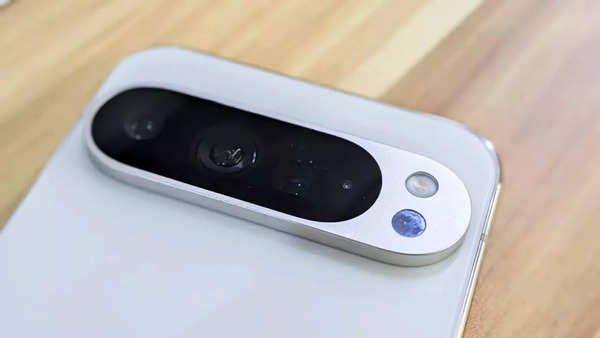
The main setup consists of three cameras: A 50MP Octa PD wide camera with an f/1.68 aperture, 82-degree field of view, and a 1/1.31-inch image sensor size. There is a 48MP Quad PD ultrawide camera with autofocus, an f/1.7 aperture, 123-degree field-of-view, and a 1/2.55-inch image sensor size. The third is a 48MP Quad PD telephoto camera with an f/2.8 aperture, 22-degree field-of-view, 5x optical zoom, Super Res Zoom up to 30x, and a 1/2.55-inch image sensor size.
All the hardware with features like multi-zone LDAF (laser detect auto-focus) sensor for quick and accurate focusing in diverse shooting scenarios, flicker sensor to avoid flickering in artificial lighting and optical + electronic image stabilisation on wide and telephoto lenses to minimise blur make this setup a powerful camera system. All this is combined with Google’s advanced image processing algorithms and AI features.



The primary lens captures stunning detail and vibrant colours in various lighting conditions while the ultrawide lens excels at capturing expansive landscapes, with macro focus capabilities for close-up detail.
The Pixel 9 Pro XL’s primary camera excels at capturing detailed images with impressive dynamic range and sharpness. It is one of the fastest phones for point-and-shoot- photography and captures accurate and true to life photos in favourable lighting conditions. The ones clicked in not-so-favourable conditions need some processing before the final image is presented.
Portrait mode performs well even in challenging lighting conditions, offering 1.5X, 2X, and 3X options. However, edge detection can be inconsistent, missing out on details like hair or even taking into account faces in the background into focus.
The 5X telephoto camera captures sharp, detailed photos in various lighting conditions. Image quality remains decent at 10X zoom, but deteriorates beyond that. While the new Zoom Enhance AI tool can improve sharpness in images captured at 15X or 30X, the results aren’t groundbreaking. We mostly used it for documentation during conferences and trips.



The ultrawide camera produces acceptable images in daylight, with occasional colour shift. We really liked the quick macro mode switching when taking closeup shots.
Another thing that we think has been streamlined but still needs work is the seamless switching of lenses. The switching has drastically improved from 1x to 2x but there is still a ‘jerk’ when the camera shifts to the telephoto lens.
The Video recording on Pixel 9 Pro XL has improved and it benefits significantly from the new VC cooling system, preventing overheating and maintaining consistent quality. Furthermore, the phone still tends to heat up quickly when using the camera for a longer period of time.
While the Pixel 9 Pro XL delivers good overall video quality, it still needs further refinement to match the video capabilities of the leading iPhone Pro models.






Video Boost, which was introduced with the Pixel 8 Pro, has been enhanced on the Pixel 9 Pro XL. Google claims faster video rendering and introduces 8K upscaling and HDR+ support. Video Boost effectively reduces noise, improves contrast and colours, and stabilises footage, even in low-light conditions with Night Sight Video.
On the front is a 42 MP Dual PD selfie camera with auto-focus, ƒ/2.2 aperture and 103-degree ultrawide field of view. The selfie camera does a fine job, though, portraits may sometimes be inconsistent.
Google Pixel 9 Pro XL battery
The Pixel 9 Pro XL boasts impressive battery performance with its 5,060mAh battery. This easily provides enough power to last for a full day with moderate to heavy use. The phone supports fast charging via a USB Type-C cable, reaching up to 70% charge in approximately 30 minutes with the Google 45W USB-C charger (sold separately). It also offers fast wireless charging capabilities and Battery Share functionality for powering other devices.
Verdict
At a price of Rs 1,24,999, the Google Pixel 9 Pro XL is a compelling flagship smartphone that showcases Google’s commitment to AI and software innovation. While it may not outperform competitors in raw processing power, its strength lies in its intelligent software, seamless AI integration, and impressive camera capabilities. Its refined design, vibrant display and powerful AI performance not only makes it a joy to use for everyday tasks but also separates it from the traditional smartphone definition. Its AI-powered features, like Gemini Live and the enhanced Magic Editor, offer a glimpse into the potential of AI to enhance everyday tasks and creativity.
The camera system, a hallmark of Pixel phones, continues to deliver excellent image quality and introduces innovative AI features like Add Me and Zoom Enhance. However, some inconsistencies prevent it from achieving absolute camera perfection.
Ultimately, the Pixel 9 Pro XL is a strong contender in the flagship market, particularly for users who want AI features, a clean Android experience, and a camera that excels in various situations. If you’re looking for a smartphone that seamlessly integrates AI into everyday tasks and offers a glimpse into the future of mobile technology, the Pixel 9 Pro XL is certainly worth considering.


